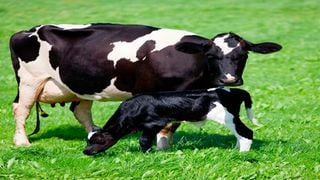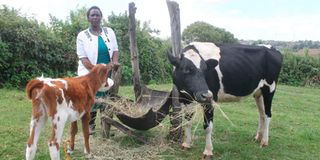
Some of the common calving problems are retained afterbirth, difficult calving, milk fever, downer cow syndrome, mastitis and metritis.
| ShutterstockSeeds of Gold
Premium
Seven cow calving challenges and their remedies
What you need to know:
- Retained afterbirth happens when the animal fails to expel the foetal sac 24 hours after calving.
- Milk fever is an acute, flabby/partial paralysis that affects mature cows entering their third or more calving.
Any farmer aspires to have their cows produce a calf every year for more milk production, replacement of heifers or have more animals for sell.
However, the calving period comes with several challenges that if not well-managed can dim the hopes of any farmer.
These include retained afterbirth, difficult calving, milk fever, downer cow syndrome, mastitis, and metritis in that order. Studies show that there is 67 per cent chance of encountering one of these constraints. The conditions are common 2-3 weeks before, after or during birth.
Retained afterbirth (RAB)
RAB happens when the animal fails to expel the foetal sac 24 hours after calving. Normally, expulsion takes place 3-8 hours after delivery. Even in animals that do not have any health problems, there is a 5-15 per cent chance of an animal developing a RAB.
However, in most cases, there are pre-disposing causes that include abortion, difficult calving, stillbirth, calcium deficiency, advancing age and nutritional deficiencies. Diagnosis of RAB is visual where the placenta can be seen protruding from the animal’s birth opening after the calf has been delivered.
Common practices with small-scale producers include pulling or cutting the membranes, attempt to remove them as vets do, feed the animal with maize to cause constipation with the hope that as the animal strains to defecate, the placenta will also come out and sometimes to tie a heavy object on the hanging material, hoping that the weight of the object will remove the offending remains. All these compound the problem with maize feeding leading to the life threatening lactic acidosis.
Pulling leads to bleeding which if excessive can cause death and removal of the placenta using dirty hands predisposes the animal to infection of the uterus.
Some professionals recommend no interference with the placenta, insisting that it will fall off 2-11 days after delivery. But in the field, good results have been observed after hygienic removal by a veterinarian who gently peels off the placenta from the uterus and thereafter inserts some antibiotic tablets (pessaries) to prevent secondary bacterial infection.
Serving animals with bulls which have proven calving ease, using artificial insemination to prevent breeding diseases, supplementing animals with Vitamin E and selenium, culling aged cows and handling of such incidences by professionals reduces RAB incidences.
Difficult calving (Dystocia)
Calving is difficult for both the mother and the calf and even with good management, 10-15 per cent of heifers and 3-5 per cent of mature animals can experience dystocia. Predisposing factors include the cow’s pelvic size, body weight and age, calf’s birth weight/presentation at birth, number of calves in the uterus, pregnancy length, season of the year, calving ease of the father and nutritional status of the animal at calving.
The challenges can be addressed through selection of heifers with a big pelvic area, serving heifers with bulls with good calving ease and low calf birth weight, culling aged cows, avoiding over-feeding animals (fat animals experience dystocia and reduced milk production), use of sexed-semen to produce more heifers (bull calves are more likely to lead to dystocia), timing calving to coincide with the rainy season when there are plenty of feeds and setting aside a calving area where close observation can take place for early intervention.
Milk fever
Milk fever (low calcium/hypocalcaemia) is an acute, flabby/partial paralysis that affects mature cows entering their third or more calving. This takes place within 72 hours after calving. A characteristic sign of this condition is twisting of the neck backwards in an animal that is lying down and it appears unresponsive.
The body temperature is usually normal or below normal. Predisposing factors include breed (Jerseys are more prone), high milk production which is associated with loss of calcium and age of the cow with a 9 per cent risk for subsequent calving and diet.

Linet Cherono on her dairy farm in Elburgon, Nakuru County.
Feeds that are high in sodium and potassium are associated with milk fever, while those high in sulfuric and hydrochloride salts of calcium and magnesium are preventive. About 60 to 70 per cent of milk fever cases die if not treated. Shortage of injectable calcium as is the current situation leads to huge losses through death.
To curb the disease, administer calcium by mouth or subcutaneous injection at calving and 12 hours later, partial emptying of the udder after calving and close observation for prompt treatment of animals with a history of milk fever. Current innovative techniques include cation-anion difference (CAD) which is a method of feeding diets with a balance of sodium, potassium, sulfuric and hydrochloride salts.
Other methods include use of calcium binding salts that reduce calcium in the blood necessitating the body to stimulate the hormone that mobilises calcium from the blood and absorption of dietary calcium through the intestines. However, applicability and availability of the last two innovations in the country is limited.
Downer cow syndrome (DCS)
Here, an animal that has calved is unable to rise after 24 hours of lying down. Two common predisposing factors of DCS include milk fever, especially if the animal does not respond to two treatments for milk fever.
The other one is lack or inadequate supplemental feeding in late pregnancy or after calving. A DCS animal is normally alert, eats and feeds well and has a normal temperature. Prolonged contact with the ground might lead to permanent nerve damage.
Management of DCS includes physical, chemical and nutritional treatment. Physical care involves placing the animal under a shade and on a soft surface that include a layer of one-foot-thick straw or sand. The animal can be rolled from one side to the other at least three times a day to avoid nerve damage through contact pressure.
Chemical therapy includes administration of calcium if it had not been done already. Also administer potassium, magnesium and phosphorus if calcium injection does not work and injection of selenium and vitamin E. Nutritional supplementation with high quality fodder, dairy meal and mineral salt should be done. The feed and water should be availed throughout the treatment period. With good management, an animal should be able to rise within 14 days, failure to which consider disposing it.
Mastitis
Mastitis is the inflammation of the udder and or teats and it is accompanied by changes such as colour, consistency and smell of milk. Bacteria are the most cause of mastitis. Pre-calving mastitis is often due to improper drying-off (final milking at the end of a milking period), dirty beddings and environment. Post-calving mastitis is often due to unhygienic handling of milking sessions.
Previously, sudden milking cessation combined with long acting antibacterial suspensions has been used to dry-off cows, but this is being discouraged due to the widespread antimicrobial resistance.
Decreased feeding combined with reduced milking frequencies is effective in reducing milking production at drying. Post-calving, a dry/clean cowshed and milking parlour; clean milker’s hands and equipment especially the drying cloth are very important.
Metritis
Metritis is the infection of the uterus. It occurs within the first 14 days after calving and it is associated with bacterial contamination of the reproductive tract. Predisposing factors include difficult calving and milk fever. Proper handling of the two reduces its incidences.
Udder oedema
This is excess swelling of the udder which might extend to between hind legs, the chest and the fore legs. The condition is not painful and it is due to accumulation of fluids. Predisposing factors include age with heifers being more at risk. Inadequate exercise also contributes. Massaging the affected area with warm water after milking relieves the problem in due course.
Dr Mwirigi is a livestock production specialist. [email protected]





